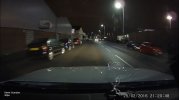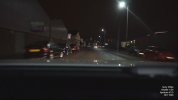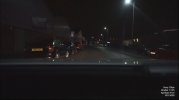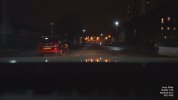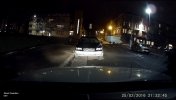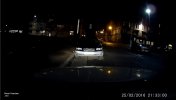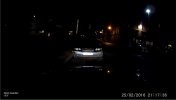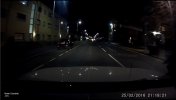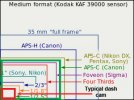Colour temperature can effect clarity but that's more with how our eyes render detail under different lighting conditions, but with registration plates it's about dynamic range as they are essentially becoming highlights when our lights hits them and the detail is being blown out. Very similar to photography, I find a lot of similarities cross over between photography and dash cams.
A camera sensor's dynamic range will only be able to expose for a certain amount of the full dynamic range of the scene. The rest will either be overexposed or underexposed - or a combination of both.
It's like when you take a photo of someone on a bright sunny day with some nice fluffy clouds with a cheap camera. The camera will expose for the person and surroundings, but the sky which is much brighter will not show as nice and blue with fluffy clouds but will simply be white because the dynamic range of the camera isn't wide enough to expose for the darker ground scene and the brighter sky scene. More expensive cameras have a greater dynamic range, typically because their sensors are bigger and therefore the individual pixels are bigger and can collect more photons so to speak. This is also why more resolution is not necessarily better because you can introduce more noise into the image and also lose dynamic range.
Here's a good image to show how dynamic range works within the whole scene:

There's only really two solutions with the actual camera technology to fix blown highlights such as registration plates and make them readable:
1. Automatic switching metering (I don't even think this exists!)
I say "switching" rather than adjustable because light metering is always adjusting - but it's the type of meting which needs to switch and typically you have three types of light metering: Wide, Centre and Spot.
- "Wide" assesses the whole scene and provides the best overall exposure. This is good for dash cams at night because the majority of the scene will be dark so it will shift the dynamic range of the device accordingly to pull back detail in the darker areas, however, this will cause more of the brighter parts of the scene to overexpose and in particular registration plates because their bright area only makes up for a small percentage of the overall coverage of the scene so the metering will not give it very much priority.
- "Centre Weighted" assesses a pre-defined central area of the scene and exposes for this. Depending on how large or small the central area is this can be the best of both worlds. It may be large enough to include a good portion of darker areas and expose for this but as a brightly lit registration plate comes into the scene and more importantly this bright part of the scene comprises of a decent percentage of the metering areas it will shift the dynamic range accordingly so that brighter areas are better exposed whilst still trying to retain detail in the darker surrounding areas.
- "Spot" which is basically like Centre Weighted except like the name suggests Spot metering uses only a very small area in the middle of the scene to expose. This should expose registration plates perfectly, but it will most definitely underexpose the rest of the scene and probably not far off pitch black.
The camera's metering system would have to be setup so that if it detects bright light in the central part of the scene then it will switch from wide to centre weighted and then onto spot should it get even brighter in the middle. This way you would have a nicely exposed night scene during general driving about, but as you come close to a plate then it will expose for this, but then you could end up missing some surrounding action as it will become underexposed. It's not really an ideal solution but it would be better than have a single fixed exposure type.
2. Wide Dynamic Range
Easier said than done to be properly effective, especially because of two key demands of customers with dashcams: Device size and Cost. Because as you can see from the image, the wider the dynamic range the more detail can be captured in highlights and shadows before it's lost. There's only so much you can do with software and other tricks to increase dynamic range (such as removing the gaps between pixels etc), but ultimately you need bigger pixels. This means a bigger sensor (especially if the resolution is going to increase) which means a bigger device and a bigger sensor will be far more expensive. I suspect dash cam sensors will be tiny but could you imagine an APS-C or full frame sensor in a dash cam? Would be lovely!
There's also keeping the resolution lower which helps but then the less pixels the less detail. 1296p will render more detail than 1080p (if the sensor and lens quality is the same for both - sensor quality also very important) but if they are both on the same size sensor then the 1080p should give better low light performance but at the expense of detail. But then as dynamic range decreases so does detail! lol So it's quite the balancing act and a proper wide dynamic range is a big ask. Dynamic range also decreases as the ISO goes up, so the more the camera has to ramp up the ISO so that it can cope with a darkening scene then the less dynamic range you'll have and subsequently less detail.
There is another factor which effects low light performance which is the lens speed, basically the max aperture it can go to or is fixed at. The wider the lens can open the more light it can take in, but then your depth of field becomes very shallow which typically isn't a problem on dashcams due to the massive wide angle. If you can let more light in then the scene in general will be brighter and therefore the metering can shift more towards exposing for the brighter scene and help reduce the blown reg plates. But as we have dash cams already using very fast lens speeds I don't think there's much more that can be done there.
I used to photography using a couple of D3 bodies which are full frame sensors and had lovely dynamic range. However, I gave up photography and just got a Sony A6000 which is compact yet has an APS-C sensor. It's smaller than the D3 sensor yet the dynamic range is higher at 13.1 Evs whereas the D3 is 12.2 Evs. This will just be due to technical advances though because the low light performace of the D3 still dwarfs the A6000, it's not far off double in fact. There's a lot of other factors inolved and it's not just sensor size, but it is usually the most important aspect.
I'm tempted to setup my A6000 on the dash and do a video test just to see the difference. I actually think the tech in some of these dash cams is very good but will be interesting to see.
Kind of rambled on there! lol



